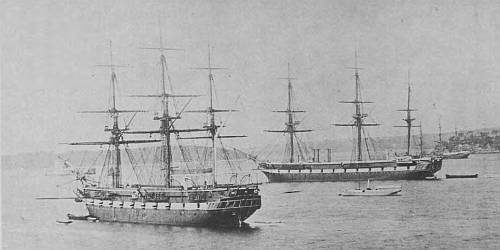- Author
- Cowburn, Professor P. M.
- Subjects
- None noted
- Tags
-
- RAN Ships
- None noted.
- Publication
- August 1972 edition of the Naval Historical Review (all rights reserved)
HOW EXCELLENT the best naval journals and memoirs can be! Indeed, even the average ones have a directness and authenticity of observation that are often missing in more self-conscious descriptive writing, while the best journals are of quite extraordinarily fine composition, the texts sometimes enhanced by excellent calligraphy and the title pages adorned with drawings or decorations of a very high standard. Others, as might be expected, are a catalogue of statistics or routine duties so that the writer’s personality is completely obscured. It is the intention of this essay to discuss the value of this kind of writing, and, by way of illustration, to consider a few of the officers who served on the Australian Station in the last decades of the nineteenth century and have left behind them records of their service.

Logbooks are a more professional record than journals and are therefore likely to be less interesting, though even they can be shot through with unexpected shafts of light, if the writer has both imagination and ability. The habit of keeping a journal, formed at an early age, and the necessity of writing regular letters to far-distant relatives often lasted a lifetime and made the writer, however taciturn in conversation, able to describe and comment on his experiences at sea with fluency and candour, and almost always with a trained eye that missed few details. Also, just as it is easy to train a soldier to describe a landscape by means of such a device as a superimposed clockface – ‘church tower; two o’clock; clump of trees’, and so on – so techniques can be learnt by midshipmen which ensure a systematic appraisal of events and guarantee a minimum of omissions. As an example of the purely professional approach, we might look at a typical entry in the logbook of Midshipman George Talbot Wingfield, which reads as follows:
Anchored in Hobson’s Bay, Saturday, 27th November 1869. A.M. Employed as most requisite. P.M. 1.30 Out first launch and pinnace. 4.30 Mended furl of sails. Received jolly boat from flagship. Received fresh beef and vegetables. 6.00 Mustered by divisions. Served out clean hammocks. Sunset Up boats.
The writer was, in fact, a fifteen year old boy, and it was the day he first reached Australia – yet his personal excitement, if he felt any – and it would have been strange if he did not – has vanished behind the rather untidily written ‘required information’. Twenty years later, the writer of this account was a captain with fifteen years of service ahead of him – in fact an officer who had done well – so it can be reasonably inferred that the young gentlemen of the gunroom were encouraged to be factual and exact rather than personal and descriptive. Yet these brief entries have a value of their own as they often provide exactly the details of information that we might otherwise miss: a few days after the above passage was written, we learn that Wingfield’s ship, HMS Phoebe, was open for inspection on a Sunday before leaving for Sydney and Tasmania, that Divine Service was held at 10 and 6.30 on Sundays and that first the port watch and then the starboard watch were given general leave for forty-eight hours while those remaining on board were employed with a detailed inspection of the rigging, painting the masts and yards and generally cleaning the ship. Thus a study of even the most unpromising material may reveal some hidden ore, and, it is possible for the historian to write with confidence, in this case, about life on board a warship, how shore-leave was organised, and whether the ships were ever open for public inspection.
An example of the best kind of journal, and therefore one of particular value to the naval historian, is that of John Thomas Ewing Gowlland, a surveyor of ability. He was no mean artist, a skill he shared with his slightly older contemporary, Owen Stanley, for both surveyors had the ability to depict, often entirely successfully, a coastline, a group of aborigines crouching on some remote shore or a ship riding the waves. Gowlland joined the Navy as a master’s assistant in 1853, and while still little more than fifteen years of age served in the Archer in Napier’s Baltic Squadron during the Russian War. His journal contains some remarkable watercolour sketches. There is, for instance, the drawing of several British ships engaging the fortifications at Riga with the spires of the city, the fort and the shot furnace in the background below a pearly rift in an otherwise sombre sky and the warships set like chessmen on a churned-up sea of alternating patches of white and grey. Again there is his Squall off Memel Lighthouse, a clever study in greys and blacks, though perhaps more conventional, with its ship riding the storm and unearthly zigzags of lightning parting the clouds.




